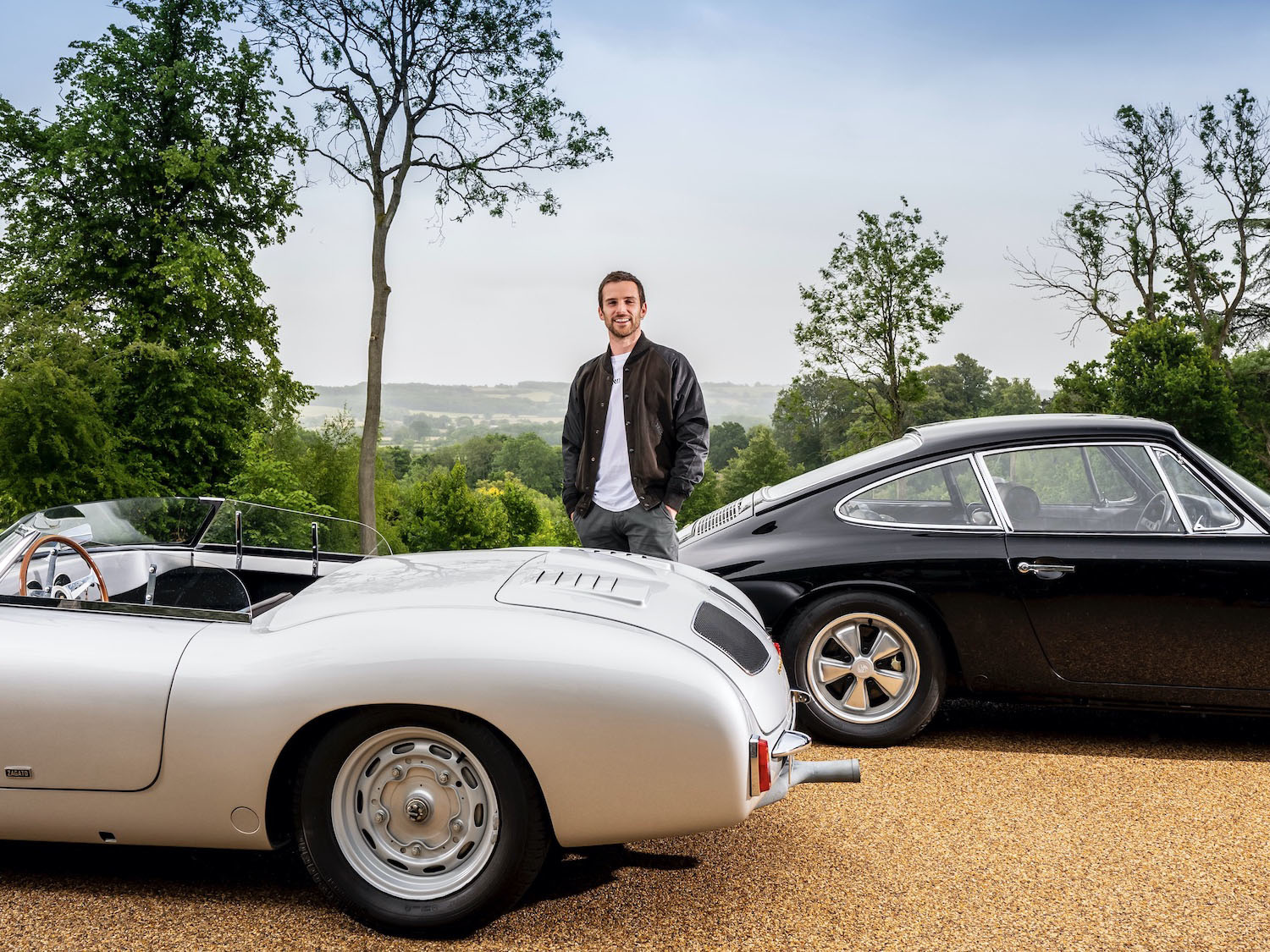Classic car enthusiasts come from all walks of life. Often, they have one brand, a decade of models, or a particular designer that they fancy. Most have names that don’t leap off the page. Guy Berryman is one of those. However, to fans of the band Coldplay, his name is very recognizable.
Berryman is one-fourth of the band, playing bass as Chris Martin takes center stage and most of the headlines. Away from the stage, Berryman has another passion – collecting and restoring classic sports cars. He’s also the creative director of “The Road Rat”, an automotive quarterly.
The two models Berryman shows off here are rare models that have been restored.Photo courtesy of Porsche AG
In a recent interview with Porsche, Berryman told how, growing up in Scotland in the 1980s, he could frequently be found behind the wheel of his father’s Triumph TR3A as it sat in a cobweb-filled garage. That car sparked what would evolve into a full-blown passion for automobiles.
Before Coldplay hit it big, Berryman was a mechanical engineering student at University College London. During a tour of his collection at his home in the Cotswolds, Berryman told Porsche, “My interest in cars fundamentally lies with the engineering and concepts behind them … All of the cars in my collection have something significant beneath the surface. I’m a great believer in the idea of form following function, and it’s something that works for me across a range of different fields. Whether its industrial design, clothing or cars, if you follow that mantra you always end up with real purity.”
Berryman’s collection isn’t filled with rough Italian muscle or elegant Scandinavian horsepower. His favorites are mid-20th century European exotics. “I think there was a design language in the 1950s and 60s that had a very beautiful, sculptural quality to it as a result of things being drawn by hand,” he said. “Back in the 60s I think there was a real flamboyance, spirit, and energy in automotive design that resulted in these very pure forms.”
Storing them in the garage is only part of his fun. Berryman has a workshop on-site where models are able to be restored. It’s full of projects in various states of repair. “My interest in being hands-on, in pulling cars apart and rebuilding them, has an obvious connection to my past in mechanical engineering. I’m fascinated by learning, deconstructing – I think everything I do in life creatively involves looking at an object and deconstructing it, either mentally or physically. It’s how my brain works,” he said.
For Berryman, it’s more than just fixing a vehicle. He often finds himself deep in the details of the car, unraveling its history, contacting previous owners, and venturing into the archives. “I go to great lengths to restore cars in a way that is true to how they would have left the factory – replicating materials, finishes and colours – often details you would never see, such as inside a panel or door. Anything that is found during disassembly has to be preserved or recreated when the car is put back together,” he told Porsche.
Berryman owns five classic Porsches. The company detailed them as part of the interview:
“An immaculately restored 1967 911S shares garage space with a 914/6 converted to GT specification and a totally original 911 from 1968 that once belonged to Porsche modifier and founder of Rennenhaus, Clay Grady. Grady’s battle-worn 914 racer is also in Berryman’s possession, as is an ultra-rare 356 Zagato, one of nine continuation cars built to the drawings of the little-known one-off 1958 racer.”
“It’s a great car,” Berryman says, describing the 914. “It’s light as a feather and so open. And it’s the car that has given me the greatest road trip of my life so far. I picked it up from Zagato in Milan with my friend Magne Furuholmen from A-ha and drove it up through the lakes, across to Chamonix and all the way down the Alps to Nice. We drove through the most inclement weather you could possibly imagine. There were lightning storms and visibility was down to about four metres on these twisty alpine roads. People in modern cars had decided it was unsafe to carry on but we had to get to Nice by a certain time so we ploughed on in these bright yellow raincoats with the car filling up with water. Each night when we got to the hotel we’d have to ask for a bucket to scoop the water out of the car.”
Despite being into the classics, Berryman sees value in the direction motoring is headed – specifically electrification.
“I don’t think people drive their cars enough,” he said, “which is a shame from a personal and cultural point of view. When there really is a full stop on the combustion age we’ll see classic cars in context and appreciate them all the more. The move to electrification day-to-day is great, and the Taycan is definitely on my radar as a daily driver, but whenever I drive down the street in a classic car, it only ever generates smiles. The lives these cars have led. The stories they can tell. They’re irreplaceable.”
Guy Berryman’s Porsche 356 Zagato
Photo courtesy of Porsche AG
Guy Berryman’s Porsche 356 Zagato and 1967 911S
Photo courtesy of Porsche AG
Guy Berryman’s Porsche 356 Zagato and 1967 911S
Photo courtesy of Porsche AG
Guy Berryman’s Porsche 356 Zagato
Photo courtesy of Porsche AG
Guy Berryman’s 1967 911S
Photo courtesy of Porsche AG
Guy Berryman’s Porsche 356 Zagato
Photo courtesy of Porsche AG
Guy Berryman’s Porsche 356 Zagato and 1967 911S
Photo courtesy of Porsche AG
Guy Berryman’s Porsche 356 Zagato and 1967 911S
Photo courtesy of Porsche AG
Guy Berryman and his Porsche 356 Zagato and 1967 911S
Photo courtesy of Porsche AG
The Road Rat magazine covers
Photo courtesy of Porsche AG








